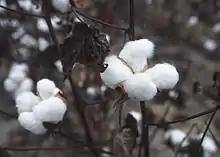Cotton recycling
Cotton recycling prevents unneeded wastage and can be a more sustainable alternative to disposal. Recycled cotton can come from secondhand clothing or from textile waste or leftovers which are then spun into new yarns and fabrics. There are some notable limitations of recycled cotton, including separation of materials that are cotton/polyester mix.[1] There may also be limits to durability in using recycled cotton.


Process
Cotton can be recycled from pre-consumer (post-industrial) and post-consumer cotton waste. Pre-consumer waste comes from any excess material produced during the production of yarn, fabrics and textile products, e.g. selvage from weaving and fabric remnants from factory cutting rooms. Post-consumer waste comes from discarded textile products, e.g. used apparel and home textiles. During the recycling process, the cotton waste is first sorted by type and color and then processed through stripping machines that break the yarns and fabric into smaller pieces before pulling them apart into fiber. The mix is carded several times in order to clean and mix the fibers before they are spun into new yarns.[2][3]
The resulting staple fiber is shorter than the original fiber length, meaning it is more difficult to spin. Recycled cotton is therefore often blended with virgin cotton fibers to improve yarn strengths.[2] Commonly, not more than 30% recycled cotton content is used in the finished yarn or fabric.
Because waste cotton is often already dyed, re-dyeing may not be necessary.[2] Cotton is an extremely resource-intense crop in terms of water, pesticides and insecticides.[4] This means that using recycled cotton can lead to significant savings of natural resources and reduce pollution from agriculture.[5] Recycling one tonne of cotton can save 765 cubic metres (202,000 US gal) of water.
Uses
Recycled cotton is often combined with recycled plastic bottles to make clothing and textiles, creating sustainable, earth-conscious products. Recycled cotton can also be used in industrial settings as polishing and wiper cloths and can even be made into new, high-quality paper. When reduced to its fibrous state, cotton can be used for applications like seat stuffing or home and automotive insulation.[6] It is also sold as recycled cotton yarn for consumers to create their own items.[7] Additionally, cotton waste can be made into a stronger, more durable paper than traditional wood-pulp based paper, which may contain high concentration of acids. Cotton paper is often used for important documents and also for bank notes since it does not wear off as easily. Cotton waste can also be used to grow mushrooms (particularly the indoor cultivation of Volvariella volvacea otherwise known as Straw Mushrooms).[8]
Even though recycling cotton cuts down on the harsh process of creating brand new cotton products, it is a natural fiber and is biodegradable, so any cotton fibers that cannot be recycled or used further can be composted and will not take up space in landfills.
See also
References
- "Looking good can be extremely bad for the planet". The Economist. Retrieved 2017-04-16.
- "Textile Exchange". Archived from the original on June 10, 2013. Retrieved February 26, 2019.
- "H&M group | Cotton". about.hm.com. Archived from the original on April 24, 2019. Retrieved April 16, 2017.
- "Cotton Farming". panda.org.
- "- BIR – Bureau of International Recycling". Bir.org. Archived from the original on 2019-01-05. Retrieved 2017-02-27.
- "eHow Style: Cotton Recycling Process". Missing or empty
|url=(help) - "Lion Brand Yarn: Recycled Cotton Yarn". Lionbrand.com. Retrieved 2012-03-23.
- "Cultivation of Edible Mushrooms on Cotton Waste". Fungus.org.uk. Retrieved 2011-11-13.
External links
Further reading
- Sowerbutts, Eli (1883) The Cotton Waste Dealers' Directory; being a complete list of waste dealers, and of all other trades connected therewith. Manchester: Heywood and Son
